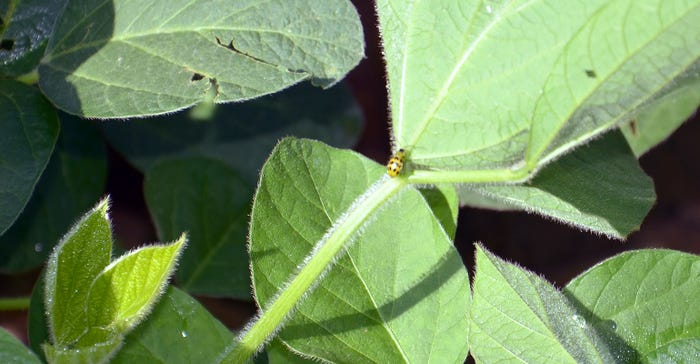
Every time Steve Gauck scouts the Soybean Watch ’17 field, he encounters a situation where he needs to confirm what he is seeing. So he pulls the Purdue University Corn & Soybean Field Guide out of his back pocket. He still relies on the original print version. The Purdue Crop Diagnostic Training and Research Center publishes a new version of this popular guide each year, typically appearing in midwinter.
“It’s a good way to be more certain about what I am finding in the field,” Gauck says. “Both pictures and descriptions of insects, diseases and other situations in the book make it easier to figure out what’s going on. When you have the pictures and details right there in the field while you are looking at the insect or problem, it’s a lot easier than sending the specimen off or trying to identify it later.”
Gauck is a sales agronomist for Beck’s, based near Greensburg, Ind. Beck’s is the sponsor of Soybean Watch ’17.
Identification
On one visit to the field, Gauck noticed a few adult beetles on plants. There weren’t enough to cause issues, but he wanted to identify which beetles he was finding. He pulled out the guide.
He determined there were both Mexican bean beetle adults and bean leaf beetle adults in the field. Mexican bean beetles aren’t as common but can be found in some fields. The larva is easily recognized because it has a soft body. The adult resembles more of a common beetle.
 TINY PEST: Steve Gauck used the Purdue guide to identify this insect as an adult Mexican bean beetle.
TINY PEST: Steve Gauck used the Purdue guide to identify this insect as an adult Mexican bean beetle.

According to the Purdue guide, adult Mexican bean beetles are round with copper-colored wings featuring 16 black spots. They can skeletonize leaves by feeding, and can also feed on pods. The guide notes that they can continue feeding all the way to harvest. Mexican bean beetle feeding on leaves would seldom approach the threshold for spraying, Gauck says.
Bean leaf beetles can be yellow, tan or red, according to the guide. They have a distinct, triangular black mark behind the head and between the wing covers. You may find bean leaf beetles that don’t have black spots on their wing covers.
If pod feeding reaches 5% of marketable pods and 10 or more beetles are present per foot of soybean row, it may pay to spray for these beetles. That means careful scouting needs to continue all the way to harvest, Gauck says.
About the Author(s)
You May Also Like




